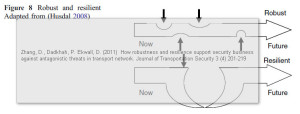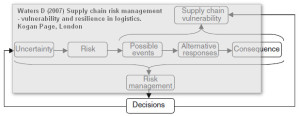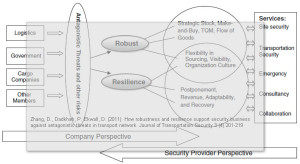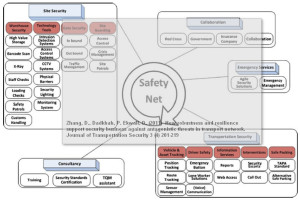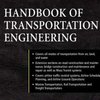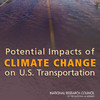 Antagonistic threats against supply chains are a special and limited array of risks and uncertainties that are demarcated by three key words: deliberate (caused), illegal (by law) and hostile (negative impact). In this paper, following up on Daniel Ekwall’s PhD thesis, Dafang Zhang, Payam Dadkhah and Daniel Ekwall suggest a suitable model of how to handle the risks and achieve security in a systematic and scientific way, where robustness and resilience play a major role.
Antagonistic threats against supply chains are a special and limited array of risks and uncertainties that are demarcated by three key words: deliberate (caused), illegal (by law) and hostile (negative impact). In this paper, following up on Daniel Ekwall’s PhD thesis, Dafang Zhang, Payam Dadkhah and Daniel Ekwall suggest a suitable model of how to handle the risks and achieve security in a systematic and scientific way, where robustness and resilience play a major role.
Revisiting an old friend
I came across Daniel Ekwall some seven years ago when I found his PhD thesis that combined theories from criminology with theories from logistics and supply chain management to examine cross-over points or antagonistic gateways between legal and illegal logistics. In his thesis, Ekwall contended that there are basically two types of threats to logistics, theft/sabotage and smuggling. The theft/sabotage problem is directly aimed towards the logistics activities, while smuggling abuses the logistics system for illegal purposes. This paper takes this issue a small step further.
Finding myself
I guess I should have paid closer attention to Ekwall’s research and writings, because then I would have discovered this paper earlier and then I would have seen that which I now – if I may be a little presumptious here – can call my legacy within supply chain risk research, namely my illustration on the differences of robustness and resilience:
In a blog post some weeks ago I asked whether what I have been writing was actually making an impact, and I concluded that the above illustration was perhaps that which I was most “famous” for, and this paper certainly confirms that assumption.
Security in supply chains
Back to the article in review, what the authors attempt to do – and succeed at, I must say – is to take current concepts and models of supply chain risk management, and adding supply chain security, not as a separate concept, but as a part of overall supply chain (risk) mangement. While most of the reviewed literature and quoted figures they highlight was quite familiar to, one figure taken from one book was new to me. This clear separation of suply chain risk and supply chain vulnerability and how they link up with risk management and decision-making is much in line with my own way of thinking:
On second thought, dwelling on why tis figure hasn’t caught my attention before, I suddenly realised that I had indeed reviewed the book it was taken from: Supply Chain Risk Management – Vulerability and Resilience in Logistics by Donald Waters. Admittedly, the reviw was done in 2008. Looking back at the review I did almost 8 years ago, I must have thought the book to be of too little academic value to me at that time.
Safety Net
Anyway, I’m sorry for digressing again, what the authors are investigating are what specific supply chain assets that are susceptible to antagonistic threats, and how supply chain security measures can apply robustness and resilience. They illustrate this with a focal model of Robustness and Resilience:
This model shows the relationship between strategies for robustness and strategies for resilience, as seen from a company perspective and from a security provider perspective.
In the company and transportation network perspective, every components of the supply chain should become robust and resilience. The robust strategy is to handle small risks ahead of the event, and manage regular fluctuations like some low impact with high likelihood accidents. Resilience strategy can help the companies adapt, improvise and overcome those disturbance and disruptions greater than the robust can handle. It helps the companies to survive after suffering from big risks and changes.
The right side of the model is further developed into what the authors call a “safety net” of services: site security, transportation security, emergency services, consultation services, and collaboration:
Site security is about protecting every node in the transferral of goods in the transportation network, e.g. warehouses, terminals, factories, and ports. Transportation security is about protecting the transportation as such, e.g. the vehicles en-roue and during parking, as well as the drivers. Emergency services provide a quick response in addition to security operations. Security providers can also act as professional consultants, and lastly, security providers are also likely to collaborate with other organisations to improve their own (and the others’) service level and the overall capability to thwart any security threats.
Conclusion and critique
Akward English sentences and lack of flow aside (see citation above), this article does have some good points. Supply chain security appears to be overlooked in supply chain risk management. However, supply chain security can add to the robustness and resileince of the overall supply chain, providing a “safety net” of services that protects, secures and enhances the overall supply chain operation.
The company versus security provider model brings together both sides of the perspective in a way that does create a consistent groundwork for building robustness and resilience. The safety net model extends beyond the supply chain and identifies the assets that need to be protected and how they can be protected.
However, after finishing reading my first thought was that there should have been a conclusion after the authors’ chosen conclusion, because the article seems to stop abruptly, leaving loose ends that could have been wrapped up a bit more, at least from an academic perspective.
That said, for a logistics and transportation manager this paper is well worth reading.
Reference
Zhang, D., Dadkhah, P. Ekwall, D. (2011) How robustness and resilience support security business against antagonistic threats in transport network. Journal of Transportation Security 3 (4) 201-219 DOI: 10.1007/s12198-011-0067-2
Author links
- linkedin.com: Daniel Ekwall
- linkedin.com: Dafang Zhang
- linkedin.com: Payam Dadkhah

